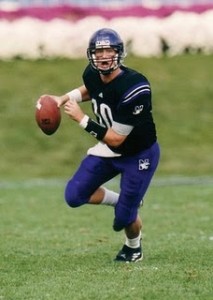When it comes to Northwestern Wildcats football, everyone usually brings up 1995, and how that team re-defined the ‘Cats. But I’ve always said that it’s really a different Big Ten championship team, the 2000 squad, who really ushered in a new era for NU. Because that was the first year Randy Walker installed the spread-option offensive system, and the program has showcased exciting, fun to watch, usually pass-happy football ever since.
And the spread has really taken off across college football since then, making the Cats rather avant-garde. And it makes sense, considering the phrase “SPREAD far the fame” is right there in the fight song.
I discussed the system with Damien Anderson, star tailback on that bellwether team, and NU’s all-time leading rusher.
By Paul M. Banks
“I think you’re absolutely right. I think the ’95, ’96 team set the tone that Northwestern could play footbal on a national level, but the spread option set the tone for college football that it can be done, it can be successful: myself, Zak Kustok, Tedy Johnson, Sam Simmons.
I was putting up 200 yard games back to back.
Look at Florida, Utah, Urban Meyer and the success that they have had. Rich Rodriguez is at Michigan now, he initially started it at West Virginia,” Anderson said.
“We were coming off a 3-8 season and we just wanted to win. And this system created some huge running lanes, those really haven’t been duplicated. And it set the tone that you could get some smart players, and combine that with athleticism together- you could have a very productive team. And it’s worked for the past ten years, look at myself, Jason Wright, Noah Herron and Tyrell Sutton,” he continued.
Very true, when you convert a very high percentage of the spread’s staples: fly and post patterns, out and slant routes, it spreads out the defense creating space for inside runs like draws and traps. On October 9th, Northwestern invited the 2000 conference title team back to Evanston to be honored at halftime.
“That’s what building a football legacy is about, paying homage, paying respect to those that have shown you can be successful at Northwestern. That’s what recruiting is about, it’s all about bringing the heroes of yesteryear back so people can put that face with that program, and they can identify the people who have done it.
It’s like in the real world, customer service, showing appreciation. It’s much more than just seeing a picture and a trophy. And it was great to give them something to look forward to and something to aspire to be,” Anderson said.
I concluded our interview by asking how NU can not only become “Chicago’s Big Ten team,” like the marketing slogan, but Chicago’s college football team.
“Given the success since 1995, the back to back Big Ten championship teams since Pat was playing, Chicago has done nothing but embrace Northwestern football because we’re looked upon as an underdog, a private university known for it’s education. And then we get out there and we step up the pace, and we play physical, we have a lot of fun and energy and we’re smiling.
And the head coach takes on that personality. With Gary Barnett there was finesse, but also power and an intense hunger to win. With Randy Walker it was a stone cold, we’re going to outwork you and with Pat Fitzgerald, he has a unique type of leadership. He has an incredible buy-in from his players, he gives them value and input. And instead of having one or two players playing well he has an entire team playing well and I would take that over any heralded, ranked opponent, because that’s what will continually produce winners and when you have winners, people will want to talk about you, write about you, and be involved in your program.
And having ESPN Gameday here puts in perspective where Northwestern is at and that’s at a national level.
For part one of the Damien Anderson interview go here.
For an exclusive with Darnell Autry go here.

